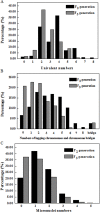Chromosomal Behavior during Meiosis in the Progeny of Triticum timopheevii × Hexaploid Wild Oat
- PMID: 25950431
- PMCID: PMC4423983
- DOI: 10.1371/journal.pone.0126398
Chromosomal Behavior during Meiosis in the Progeny of Triticum timopheevii × Hexaploid Wild Oat
Abstract
The meiotic behavior of pollen mother cells (PMCs) of the F2 and F3 progeny from Triticum timopheevii × hexaploid wild oat was investigated by cytological analysis and sequential C-banding-genomic in situ hybridization (GISH) in the present study. A cytological analysis showed that the chromosome numbers of the F2 and F3 progeny ranged from 28 to 41. A large number of univalents, lagging chromosomes, chromosome bridges and micronuclei were found at the metaphase I, anaphase I, anaphase II and tetrad stages in the F2 and F3 progeny. The averages of univalents were 3.50 and 2.73 per cell, and those of lagging chromosomes were 3.37 and 1.87 in the F2 and F3 progeny, respectively. The PMC meiotic indices of the F2 and F3 progeny were 12.22 and 20.34, respectively, indicating considerable genetic instability. A sequential C-banding-GISH analysis revealed that some chromosomes and fragments from the hexaploid wild oat were detected at metaphase I and anaphase I in the progeny, showing that the progeny were of true intergeneric hybrid origin. The alien chromosomes 6A, 7A, 3C and 2D were lost during transmission from F2 to F3. In addition, partial T. timopheevii chromosomes appeared in the form of univalents or lagging chromosomes, which might result from large genome differences between the parents, and the wild oat chromosome introgression interfered with the wheat homologues' normally pairing.
Conflict of interest statement
Figures





References
-
- Wilson AS (1875) Wheat and rye hybrids. Transactions of the Botanical Society of Edinburgh 12: 286–288.
-
- Le HT, Armstrong KC, Miki B (1989) Detection of rye DNA in wheat-rye hybrids and wheat translocation stocks using total genomic DNA as a probe. Plant Molecular Biology Reporter 7(2): 150–158.
-
- Friebe B, Jiang J, Raupp WJ, Mclntosh RA, Gill BS (1996) Characterization of wheat-alien translocations conferring resistance to diseases and pests: current status. Euphytica 91(1): 59–87.
-
- Backhouse WO (1916) Note on the inheritance of “crossability”. Journal of Genetics 6(2): 91–94.
-
- Riley R, Chapman V (1967) The inheritance in wheat of crossability with rye. Genetical Research 9(03): 259–267.
Publication types
MeSH terms
LinkOut - more resources
Full Text Sources
Other Literature Sources
Miscellaneous

